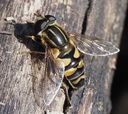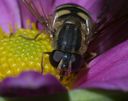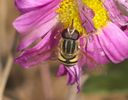Helophilus fasciatus
Classification
- Phylum: Arthropoda
- Subphylum: Hexapoda
- Class: Insecta
- Order: Diptera
- Family: Syrphidae
- Subfamily: Eristalinae
- Tribe: Eristalini
- Subtribe: Helophilina
- Genus: Helophilus
- Species: fasciatus
Pronunciation
How to pronounce Helophilus fasciatus: /hɛˈloʊfɪləs fæˈsaɪətəs/
These audio files are automatically generated. While they are not always 100% accurate, they are a good starting point.
Images






Summary
Helophilus fasciatus, known as the narrow-headed marsh fly, is a prevalent syrphid species in North America, notable for its hovering flight and role as a pollinator. Found in wet habitats, its larvae are associated with decaying organic matter, while adults exhibit a distinctive appearance that aids in identification.
Physical Characteristics
Adults are 10-15 mm in length, with a distinct coloration pattern involving opaque black abdomen with large yellow spots. Males have a yellowish pollinose face, while females have all black pilose front. The wings have a cinereous coloration with hyaline areas and a luteous stigma.
Identification Tips
To differentiate between sexes, males are dichoptic with a yellow pollinose face, while females have a darker face. Examining the abdominal band patterns can also help; males usually have broader and more well-defined spots than females.
Habitat
Syrphid flies are often found near ponds or wet areas, as their larvae develop in moist, decaying organic material.
Distribution
Found transcontinentally from southern Canada to Mexico.
Diet
Adults feed on nectar and pollen from flowers, while larvae feed on decaying organic material in aquatic environments.
Life Cycle
Eggs are laid in clutches on vegetation overhanging ponds; larvae fall into the water after hatching and develop there.
Reproduction
Males engage in mating behaviors near flowers, while females lay eggs over water bodies to ensure larvae can drop into the water post-hatching.
Ecosystem Role
As pollinators, adult Helophilus fasciatus contribute to the pollination of flowering plants, while larvae help in the decomposition process by feeding on decaying matter.
Collecting Methods
- Netting adults around flowers
- Sampling larvae from ponds
Preservation Methods
- Placing specimens in ethanol
- Pinning after killing agents are used
Similar Taxa
Tags
- syrphid fly
- pollinator
- north american insects
- aquatic larvae